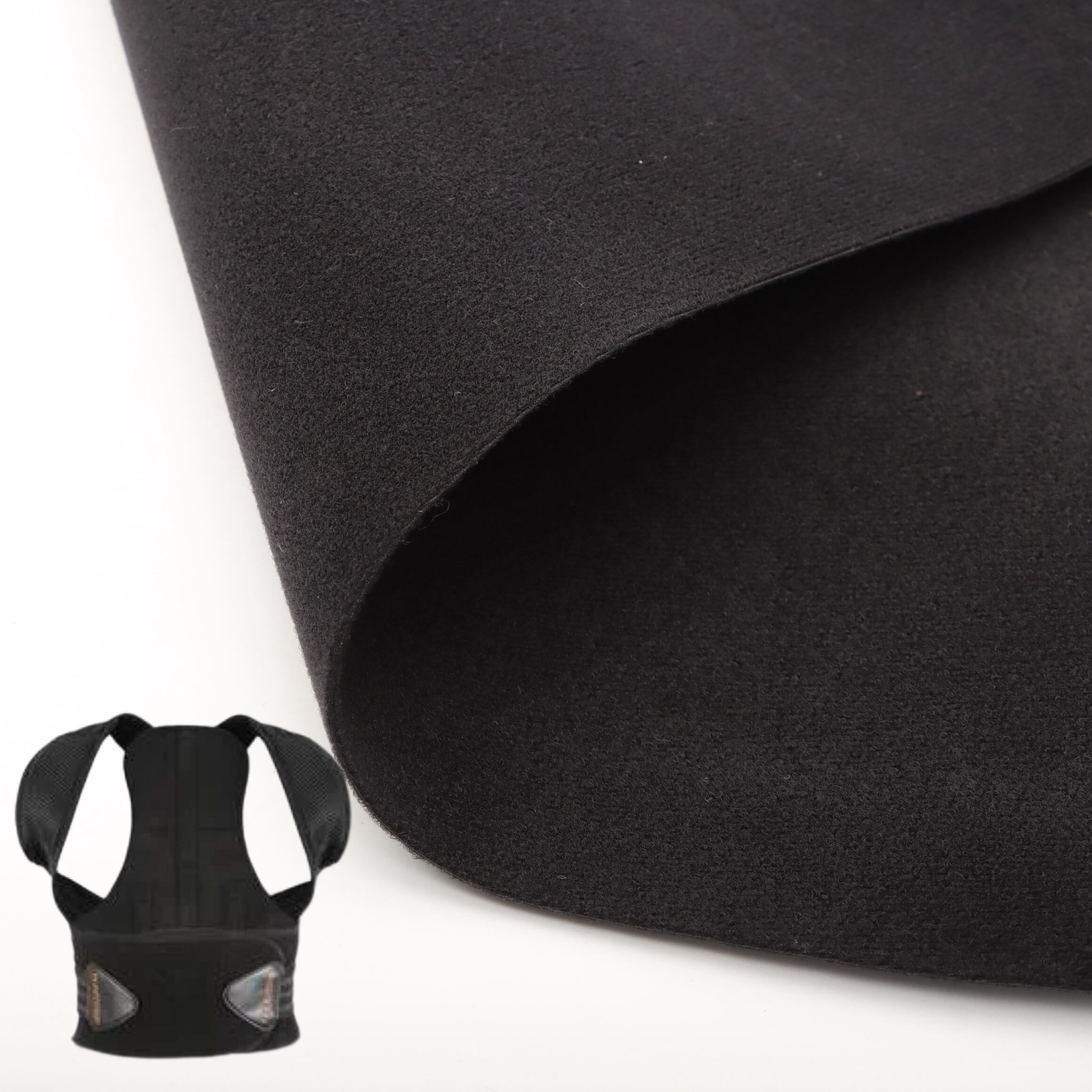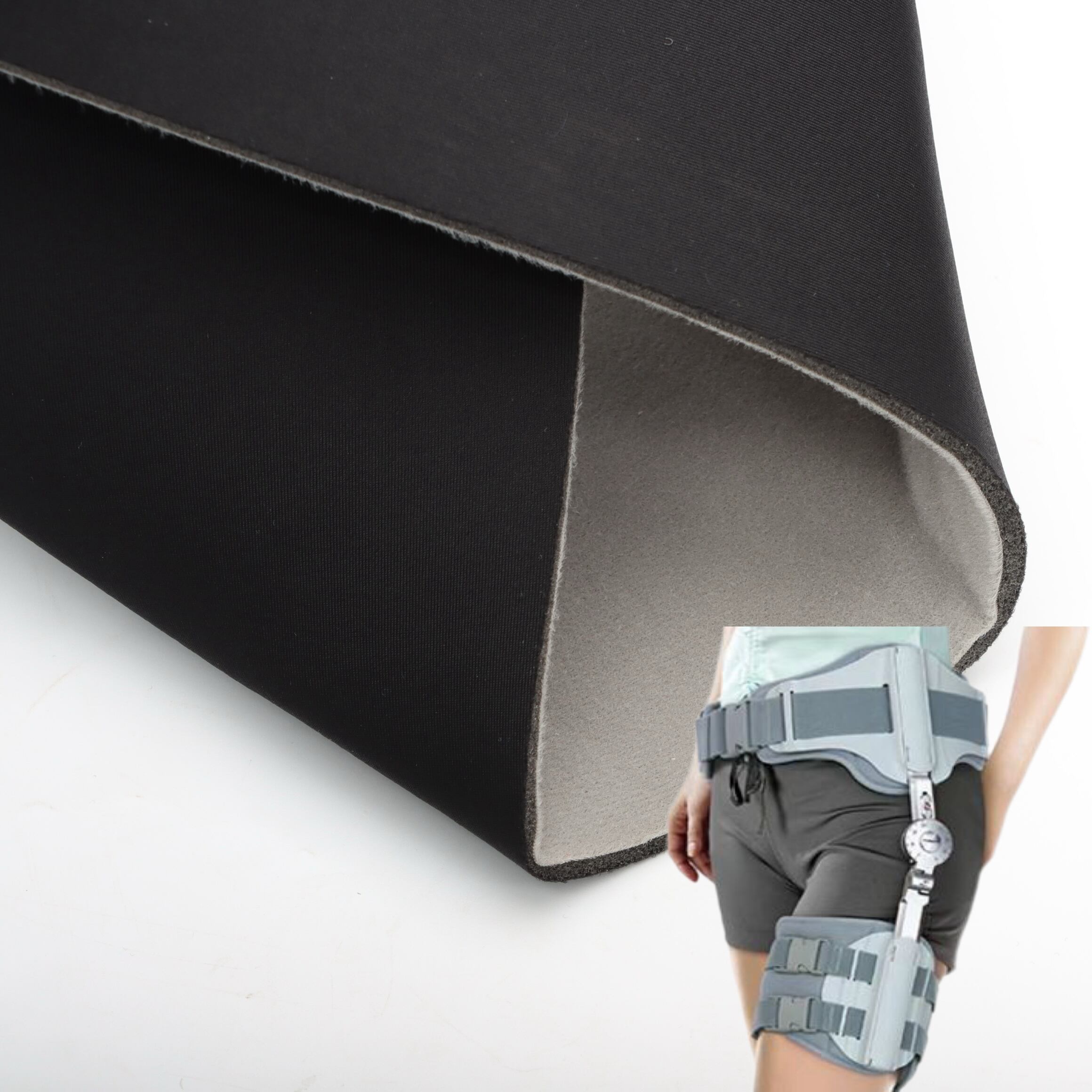لماذا يُعتبر خامة الفوم المركبة مع القماش مثالية لأحزمة ودعائم العظام؟
أصبحت الدعائم العظمية مثل الأحزمة واللفات والمعدات الواقية أكثر أهميةً متزايدةً لكل من التعافي الطبي والرعاية الوقائية. وفي قلب العديد من هذه الأجهزة تكمن مادة حيوية: خامة الفوم المركبة مع القماش . يوفر هذا الخليط الفريد من المواد الراحة والمرونة والقوة، مما يجعله الاختيار الأساسي للتطبيقات العظمية. في هذه المقالة، سنستعرض الأسباب التي تجعل ذلك خامة الفوم المركبة مع القماش أصبحت القياسية لدعامات وضمادات جهاز الحركة، وكيف يتم تصنيعها، وميزاتها الوظيفية، والابتكارات المستقبلية التي قد تعزز استخدامها.
فهم مركب نسيج الرغوة
مركب نسيج الرغوة هو مادة طبقية تجمع عادة بين طبقة من القماش الناعم مع قلب رغوي. واعتمادًا على التصميم، فقد تتضمن أيضًا طبقة لاصقة أو دعمًا إضافيًا لضمان المتانة. يمكن أن تكون المكون النسيجي محبوكًا أو منسوجًا أو غير منسوج، مما يوفر التهوية والراحة على الجلد. وتوفر الطبقة الرغوية، التي تصنع غالبًا من مادة البولي يوريثين أو مادة EVA أو النيوبرين، التخميد والمرونة والدعم الهيكلي.
يؤدي الجمع بين القماش والرغوة إلى إنتاج مادة قوية ولكنها خفيفة الوزن، ناعمة ولكنها متينة. وفي دعامات جهاز الحركة وضماداته، يُعد هذا التوازن ضروريًا لأن المادة يجب أن تستقر المنطقة المصابة وأن تسمح بالحركة.
لماذا يهم اختيار المادة في الدعائم العظمية
تُصمم دعائم وضمادات العظام لتوفير الدعم للمفاصل والعضلات والعظام أثناء عملية الشفاء أو لمنع الإصابات أثناء النشاط البدني. وفيما يتعلق بهذه المنتجات الطبية، فإن اختيار المواد يؤثر بشكل مباشر على راحة المريض وفعالية العلاج والالتزام بالاستخدام.
قد تؤدي الدعامة المصنوعة من مادة صلبة أو غير جيدة التهوية إلى تهيج الجلد وتقليل الحركة وعدم الالتزام المستمر باستخدامها. على الجانب الآخر، قد لا توفر الدعامة المصنوعة من مادة ناعمة للغاية الدعم اللازم. تحقق المواد المركبة من الإسفنج والقماش التوازن الصحيح، حيث توفر وسادة لتخفيف الضغط ومرونة للحركة ومتانة للاستخدام على المدى الطويل وتوافقاً مع الجلد لارتدائها يومياً.
مزايا المواد المركبة من الإسفنج والقماش في دعائم وضمادات العظام
الراحة والملاءمة
تتمثل إحدى الفوائد الأساسية لطبقة الإسفنج القماشي في قدرتها على الامتثال لشكل الجسم. حيث توفر الطبقة الإسفنجية وسادة لطيفة، بينما يضمن القماش سطحاً تلامسياً ناعماً ومسطحاً على الجلد. مما يجعل دعائم العظام أقل إرهاقاً وأكثر راحة للاستخدام لفترات طويلة.
خفيفة الوزن وقابلة للتنفس
غالباً ما يحتاج المرضى الذين يرتدون الدعائم إلى استخدامها لساعات طويلة أو حتى طوال اليوم. يمكن أن تصبح المواد الثقيلة عبئاً، بينما قد تحبس المواد غير القابلة للتنفس الحرارة والعرق. طبقة الإسفنج القماشية خفيفة الوزن ويمكن تصميمها باستخدام أقمشة قابلة للتنفس تمتص الرطوبة، مما يقلل من الانزعاج ومشاكل الجلد.
المرونة مع الدعم
على عكس البلاستيك أو المعادن الصلبة، يسمح الإسفنج القماشي بمرونة مُحكَمة. وهذا يعني أن المادة يمكنها دعم المفاصل والعضلات دون تقييد الحركة الطبيعية بالكامل. على سبيل المثال، في دعائم الركبة، يمكّن هذا التوازن المرضى من المشي بشكل أكثر طبيعية مع تقليل الضغط على الأنسجة المصابة.
الصلابة والمتانة
تحتاج الأجهزة التقويمية إلى أن تكون متينة أمام الاستخدام المتكرر، والتمدد، والتنظيف. يتسم مركب الإسفنج القماشي بمتانة عالية، حيث يقاوم التمزق، والانضغاط، والتآكل مع مرور الوقت. مع العناية المناسبة، تظل الأحزمة والضمادات المصنوعة من هذه المادة تحافظ على شكلها ووظيفتها لفترة أطول من تلك المصنوعة من الأقمشة الأساسية.
خيارات خالية من الحساسية وودية للجلد
بما أن الأحزمة والضمادات تُرتدى مباشرة على الجلد، يجب أن تكون المادة غير مهيجة. صُمّم العديد من مركبات الإسفنج القماشي لتكون خالية من الحساسية، مما يمنع الإصابة بطفح جلدي أو ردود فعل تحسسية. علاوة على ذلك، تمنع التشطيبات القماشية الملساء الاحتكاك خلال ارتدائها لفترة طويلة.
تعددية في التصميم
يمكن تخصيص مركب الإسفنج القماشي من حيث السماكة، والمرونة، وتشطيب السطح. يسمح ذلك لمصنعي الأحزمة بتصميم أحزمة تكون ناعمة ومرنة في بعض المناطق وأكثر صلابة في مناطق أخرى، مما يُكيّف الدعم وفقًا لاختلاف أجزاء الجسم.
تطبيقات مركب الإسفنج القماشي في المنتجات التقويمية
يُستخدم مركب الإسفنج القماشي على نطاق واسع في مختلف دعائم الجهاز العضلي الهيكلي.
أحزمة الركبة
لإصابات مثل إجهاد الأربطة أو التهاب المفاصل، توفر دعائم الركبة المصنوعة من خامة الفabric foam composite الدعم دون زيادة الحجم. فهي تسمح بالانحناء الطبيعي مع الحفاظ على استقرار الركبة.
لفات الكاحل
تتطلب دعائم الكاحل مرونة لتسهيل الحركة ودعمًا قويًا للوقاية من الإصابات. تجعل خفة وزن خامة الفabric foam composite وقابليتها للتعديل منها خيارًا مثاليًا لهذا الغرض.

دعائم المعصم والمرفق
تُرتدى دعائم المعصم والمرفق غالبًا أثناء ممارسة الرياضة أو التأهيل. يقلل تأثير التخميد من خامة الفabric foam composite من الضغط الواقع على المفاصل الحساسة مع ضمان الثبات.
دعائم الظهر والقطنية
تُستخدم خامة الفfabric foam composite في أحزمة القطنية ودعائم الظهر، حيث توفر ضغطًا وتصحيحًا للوضعية وإغاثة من آلام أسفل الظهر دون جعل الدعامة صلبة بشكل مفرط.
دعائم الكتف
تسمح لفات الكتف المصنوعة من هذه الخامة المركبة بالحركة مع تثبيت المفصل، وهو أمر ضروري للاعبين الرياضيين أثناء التعافي من الإصابات.
كيف تُحسّن خامة الفfabric foam composite من التزام المرضى
في تخصص جراحة العظام، واحدة من أكبر التحديات هي ضمان استخدام المرضى لأجهزة الدعم الخاصة بهم بشكل منتظم. يعزز استخدام خامة espuma المركبة مع القماش من الالتزام بالعلاج لأنها مريحة وخفيفة الوزن وقابلة للتنفس. من المرجح أن يرتدي المرضى الجبائر وفقًا للتعليمات إذا لم تسبب لهم أي إزعاج أو تعرق أو تهيجًا في الجلد.
التصنيع والتخصيص
يمكن تعديل خامة espuma المركبة مع القماش لتلبية احتياجات تخصصية في جراحة العظام. يمكن تعديل كثافة espuma وسمكها ومرونتها وفقًا لمستوى الدعم المطلوب. يمكن اختيار طبقة القماش من حيث النعومة أو المتانة أو القدرة على امتصاص الرطوبة. بالإضافة إلى ذلك، يمكن قص وتشكيل هذه الخامة بدقة باستخدام ماكينات CNC أو ماكينات الليزر، مما يسمح بإنتاج جبائر وأغطية مخصصة تمامًا لتتناسب مع شكل جسم المريض.
تصاميم مبتكرة
غالبًا ما تدمج الأقواس الحديثة بين الأقمشة وال espuma المركبة مع مكونات إضافية مثل أحزمة الفيلكرو والربط المطاطي أو الدعامات الصلبة. توفر الطبقة المركبة الراحة والمرونة الأساسية، في حين تقدم هذه العناصر دعمًا مركّزًا أو قابلية للتعديل. تُحسّن هذه المجموعة من العناصر كلاً من الوظيفة وتجربة المستخدم.
الاتجاهات المستقبلية للأقمشة المركبة مع espuma في الأجهزة التقويمية
تتطور الصناعة باستمرار، حيث تتركز الأبحاث على تحسين الراحة والاستدامة والوظيفة. وتشمل التطورات الجديدة الأقمشة المضادة للميكروبات لمنع العدوى، ومواد espuma قابلة لإعادة التدوير لتقليل الأثر البيئي، وتحسين إدارة الرطوبة للاستخدام لفترات طويلة. كما قد تدمج الأقواس الذكية التي تحتوي على أجهزة استشعار بين طبقاتها قماش espuma مركب كطبقة خارجية لزيادة الراحة، مع تركيب مكونات إلكترونية لمراقبة حالة المستخدم في الوقت الفعلي.
الاستنتاج
ثبت أن مادة الإسفنج المركب القماشي هي مادة مثالية للأحزمة والضمادات العظامية بفضل مزيجها الفريد من الراحة والمرونة والمتانة والملاءمة للجلد. كما أنها تدعم المفاصل والعضلات بشكل فعال مع السماح بالحركة الطبيعية، مما يجعلها ضرورية في الاستعمالات الطبية والرياضية. وبفهم مزاياها وتطبيقاتها، يمكن للمرضى وأطباء العظام والمصنعين اتخاذ قرارات مدروسة تُحسّن النتائج والراحة والالتزام.
الأسئلة الشائعة
ما هي مكونات الإسفنج المركب القماشي؟
يتكون الإسفنج المركب القماشي من طبقة نسيجية ناعمة مجتمعة مع قلب إسفنجي. وقد يكون الإسفنج مصنوعًا من البولي يوريثين أو مطاط الإيثر فينيل الإيثليني (EVA) أو النيوبرين، في حين يمكن أن يكون القماش محبوكًا أو مجدولًا أو غير منسوج.
لماذا يُفضّل استخدامه في الأحزمة العظمية؟
يوفر وسادة هوائية ومرن وداعمًا مريحًا للجلد، مما يجعل الأحزمة أكثر فعالية ويسهل ارتداؤها لفترات طويلة.
هل يمكن استخدامه في جميع أنواع الأحزمة العظمية؟
نعم، إنه متعدد الاستخدامات بما يكفي لدعامات الركبة، واللف حول الكاحل، ودعامات المعصم، وحزام الظهر، ودعامات الكتف.
هل خامة الفوم المركب متينة؟
نعم، يقاوم التمزق والانضغاط والتآكل بمرور الوقت، ويحافظ على الوظائف إذا تم الاعتناء به بشكل صحيح.
هل توجد إصدارات صديقة للبيئة من خامة الفوم المركب؟
نعم، ينتج بعض المصنّعين مركبات باستخدام فوم قابل للتدوير أو منخفض الانبعاثات مع أقمشة مستدامة.
جدول المحتويات
- لماذا يُعتبر خامة الفوم المركبة مع القماش مثالية لأحزمة ودعائم العظام؟
- فهم مركب نسيج الرغوة
- لماذا يهم اختيار المادة في الدعائم العظمية
- مزايا المواد المركبة من الإسفنج والقماش في دعائم وضمادات العظام
- تطبيقات مركب الإسفنج القماشي في المنتجات التقويمية
- كيف تُحسّن خامة الفfabric foam composite من التزام المرضى
- التصنيع والتخصيص
- الاتجاهات المستقبلية للأقمشة المركبة مع espuma في الأجهزة التقويمية
- الاستنتاج
- الأسئلة الشائعة







